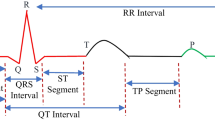Abstract
In this paper, we present a carry-save arithmetic- based coordinate rotation digital computer (CORDIC) engine for computing eight fundamental time-domain statistical features. These features are used commonly in association with major classifiers in remote health monitoring systems with an aim of executing them on a node of wireless sensor network (WSN). The engine computes all the eight features sequentially in \(3n\) clock cycles where \(n\) is the number of data samples. We further present a comparative analysis of the hardware complexity of our proposed architecture with an alternate architecture which does not use CORDIC (instead uses standalone array multiplier, divider, square rooter and logarithm converter). The hardware complexity of the two architectures presented in terms of full adder count reflects the effectiveness of using CORDIC for the given application. The engine was synthesized using the STMicroelectronics 130 nm technology library and occupied 205K NAND2 equivalent cell area and consumed 1 nW dynamic power @ 50 Hz as estimated using prime time. Therefore, the design can be applicable for low-power real-time operations within a WSN node.










Similar content being viewed by others
References
A. Acharyya, K. Maharatna, B.M. Al-Hashmi, J. Reeve, Coordinate rotation based low complexity N-D FastICA algorithm and architecture. IEEE Trans. Signal Process. 59(8), 3997–4011 (2011)
H. Alemdar, C. Ersoy, Wireless sensor networks for healthcare: a survey. Elsevier Comput. Netw. 54(15), 2688–2710 (2010)
D.D. Caro, M. Genovese, E. Napoli, N. Petra, A.G.M. Strollo, Accurate fixed point logarithm converter. IEEE Trans. Circuits Syst. II Express Briefs 61(7), 526–530 (2014)
S. Chernbumroong, S. Cang, A. Atkins, H. Yu, Elderly activities recognition and classification for applications in assisted living. Expert Syst. Appl. 40(5), 1662–1674 (2013)
M.D. Ercegovac, T. Lang, Digital Arithmetic (Morgan Kaufmann, Burlington, 2003), pp. 549–607
M. Ermes, J. Parkka, J. Mantyjarvi, I. Korhonen, Detection of daily activities and sports with wearable sensors in controlled and uncontrolled conditions. IEEE Trans. Inf. Technol. Biomed. 12(1), 20–26 (2008)
E. Grass, B. Sarker, K. Maharatna, A dual-mode synchronous/asynchronous CORDIC processor, in Proceedings of the Eighth International IEEE Symposium on Asynchronous Circuits and Systems, Apr 2002, pp. 76–83
Y.J. Hong, I.J. Kim, S.C. Ahn, H.G. Kim, Mobile health monitoring system based on activity recognition using accelerometer. Elsevier Simul. Model. Pract. Theory 18(4), 446–455 (2010)
C.Y. Kang, E. Swartzlander, Digit-pipelined direct digital frequency synthesis based on differential CORDIC. IEEE Trans. Circuits Syst. I 53(5), 1035–1044 (2006)
K. Kota, J.R. Cavallaro, Numerical accuracy and hardware tradeoffs for CORDIC arithmetic for special-purpose processors. IEEE Trans. Comput. 42(7), 769–779 (1993)
R. Kunemund, H. Soldner, S. Wohlleben, T. Noll, Cordic processor with carry-save architecture, in Proceedings of the ESSCIRC 90, Sept 1990, pp. 193–196
C.H. Lin, A.Y. Wu, Mixed-scaling-rotation CORDIC (MSR-CORDIC) algorithm and architecture for high-performance vector rotational DSP applications. IEEE Trans. Circuits Syst. I 52(11), 2385–2396 (2005)
K. Maharatna, E.B. Mazomenos, J. Morgan, S. Bonfiglio, Towards the development of next-generation remote healthcare system: some practical considerations, in Proceedings of the IEEE International Symposium on Circuits and Systems (ISCAS), Seoul, May 2012, pp. 1–4
P.K. Meher, J. Valls, T.B. Juang, K. Sridharan, K. Maharatna, 50 Years of CORDIC: algorithms, architectures, and applications. IEEE Trans. Circuits Syst. I 56(9), 1893–1907 (2009)
P. Nair, D. Kudithipudi, E. John, Design and implementation of a CMOS non-restoring divider, in Region 5 Conference, IEEE, 7–9 Apr 2006, pp. 211–217
L. Vachhani, K. Sridharan, P.K. Meher, Efficient CORDIC algorithms and architectures for low area and high throughput implementation. IEEE Trans. Circuits Syst. II 56(1), 2385–2396 (2009)
K.N. Vijeyakumar, V. Sumathy, P. Vasakipriya, A.D. Babu, FPGA implementation of low power high speed square root circuits, in IEEE International Conference on Computational Intelligence & Computing Research (ICCIC), 18–20 Dec 2012, pp. 1–5
Acknowledgments
This work was supported by the Information and Communication Technologies Theme of the European Union Seventh Framework Programme, under the project name “StrokeBack: Telemedicine system empowering stroke patients to fight back” (Grant Number 288692).
Author information
Authors and Affiliations
Corresponding author
Rights and permissions
About this article
Cite this article
Biswas, D., Maharatna, K. A CORDIC-Based Low-Power Statistical Feature Computation Engine for WSN Applications. Circuits Syst Signal Process 34, 4011–4028 (2015). https://doi.org/10.1007/s00034-015-0041-5
Received:
Revised:
Accepted:
Published:
Issue Date:
DOI: https://doi.org/10.1007/s00034-015-0041-5




